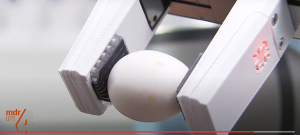Dr Andrew Chen (Matū Venture Partner) was asked to speak at the Angel Association of New Zealand (AANZ) Summit in Queenstown at the end of October, alongside Hayley Horan from Microsoft and Carl Jones from WNT Ventures. The session was about leveraging Aotearoa New Zealand’s SaaS and Deep Tech competitive advantages to build globally significant companies. Andrew mostly covered the deep tech side of the equation, and we thought it would be useful to share some of his talk notes and insights from the conference.
What are we good at?
There are some niche specialities in New Zealand deep tech where we are genuinely just very good at the science. An exhaustive list is a fools’ errand (and I apologise if we have missed your favourite area or start-up), but here is a start of some of our strengths and some of the commercial examples to back that up:
- Inductive (wireless) power transfer, originating from the University of Auckland’s Electrical, Computer, and Software Engineering Department, leading to HaloIPT and PowerByProxi.
- Medical Device Technology, with the world-class Auckland Bioengineering Institute and wider support through the MedTech Research Network, leading to Alimetry, Aroa Biosurgery, Surgical Design Studio, Kitea Health, JunoFem, Formus Labs, OPUM, Swallowing Technologies, and more.
- Materials and nanotechnology, including optics and ceramics, coalescing around the MacDiarmid Institute CoRE, leading to Magritek, Liquium, Advemto, Marama Labs, Inhibit Coatings, Humble Bee, TasmanIon, Nanolayr, Quantifi Photonics, and more.
- Biochemical extraction and recycling, which really kicked off with Lanzatech, inspiring a generation of start-ups including Avertana, Mint Innovation, Ligar, Cetogenix, and Zincovery.
- Food Technologies, with many efforts supported by the Riddet Institute, with the most recent generation of start-ups including Daisy Lab, Miruku, and Opo Bio.
- Magnets and Superconductors, with world-leading Paihau – Robinson Research Institute at Victoria University of Wellington, enabling the development of HTS-110 and OpenStar.
- Biotechnology, especially cancer treatments, with excellent research at Malaghan Institute, VUW, UoA, and Otago, now being commercialised through companies like Amaroq, TamoRx, BioOra, Avalia Immunotherapies, Ferronova, and more.
- Digital Avatars, where it is no coincidence that two of the first companies in this space originated in New Zealand through Soul Machines and UneeQ.
- Aerospace, where RocketLab has helped establish the local ecosystem that now includes Dawn Aerospace, Zenno, Astrix, Kea, AeroSearch, and more.
When we reflect on these areas, there are two common attributes: first is that we have genuine world experts who are demonstrating leadership beyond the lab, and second is that there is a common hub or network or community that fosters broader growth. When they come together we can genuinely say that we have a competitive advantage against others worldwide.
We also have some areas where New Zealand is a globally representative beachhead market, which makes our home soil a better place to experiment, such as in agritech (Halter, BioLumic, Engender, CropX, Cropsy), conservation and bioprotection (Ampersand, Wilderlab), and earthquake resilience (Tectonus, Seismic Shift). These are slightly different to the previous list because there is a lot more competition overseas, but doing it out of New Zealand offers unique opportunities and insight.
What are we not so good at?
While we have our strengths, there are some areas where we simply cannot compete with the giants on a global scale. Largely this is down to a lack of human and financial capital where the race is won with brute force and speed, rather than finesse. For example, large AI systems that need to hoover up huge amounts of data, where training a model might cost hundreds of thousands of dollars in computing time, are very difficult to build from New Zealand. The top research institutions around the world are struggling to compete with the likes of Google and Meta and Baidu, alongside the start-ups that raise hundreds of millions of dollars to make those technologies work at scale. This is not to say that we can’t apply these technologies in our niches (such as AI in agritech or AI in medical devices), but that it is very hard for us to compete in fundamental AI. Perhaps there are better opportunities for international collaboration to pair our expertise with the technical and capital resources from overseas.
There are other big scary science areas that we will just find it difficult to compete in – billions are being poured into quantum computing, we don’t have much of a biohacking community here, we are not competing on genetic engineering due to our regulatory and cultural environment, and we have relatively little investment in our oceans despite being surrounded by water. We should never say never though – even a few years ago someone saying that we could be doing nuclear fusion in New Zealand would be called a fool, but now we have a start-up kicking off their journey!
What are the broader trends affecting research commercialisation right now?
The real experts are in Technology Transfer Offices (TTOs) across the country, so we can only offer observations from our position as investors in the ecosystem. Counter to many people’s expectations, through COVID we actually saw a significant increase in commercialisation from universities; some institutions that averaged one start-up a year suddenly had four or five.
However, in 2022 the TTOs have generally seen a drop in invention disclosures, meaning fewer projects being put up for consideration. This is probably a symptom of our border closures preventing international postgraduate students from getting into NZ and working in our labs. International students are a crucial part of the academic workforce, in many research groups they are the ones who are actually doing the operationalisation and implementation work, and without them a lot of science has had to be conducted in different ways or has simply stalled. With international students now returning, we hope to see that trend reverse.
The New Zealand ecosystem also has very high levels of competition in research grant funding – the major government grants have success rates in the order of 10-15%. It can be argued that this helps weed out poor quality, but it also means many researchers are wasting a lot of time applying for grants, and then having to find other ways to support their work. I’m not saying we should approve every research grant, but 10-15% success rates are also probably not healthy.
However, we are seeing more academics take an interest in commercialisation and start-ups. It may not be very obvious because a lot of it happens quietly – generally researchers want to take their time and learn what they can in the “safe” environment of the university before they jump out of the gates and face commercial drivers. It means that as investors, the time to start supporting a company is not the day we deposit investment funds, it might be months or years before a company is even formed. Human capital has been a challenge for a long time in the early-stage ecosystem, and we have to do something about it and grow capability rather than relying too much on importing talent.
Are we trend setters or trend followers in New Zealand?
We see a risk adverseness generally in the local angel investor space when it comes to deep tech, which can be overcome if something has the “cool” factor, but what’s cool is what’s on trend. It takes a lot of bravery to be at the front of the trend, and many investors worry about getting the timing wrong and going too early. We also see investors looking for quick wins, which is fine if you only care about financial returns, but those wins tend not to deliver meaningful impact – we need to look to build long-term defendable advantages for New Zealand.
But as long as we are dependent on international pools of capital for our start-ups, we will probably largely continue to be trend followers. Local investors still want to see that a similar path has been cut before, and that there is a roadmap to future capital. When we think about capital strategy for our start-ups, with recent government interventions like NZGCP Elevate we have the capital to fund New Zealand companies for longer than we used to, but in general there is still a point where we look overseas for large funding rounds or exits. Maybe when we get to the next stage of maturity in the capital ecosystem, when we are genuinely providing end-to-end capital, then we will have the confidence to support companies long-term and see some of those bolder trend-setting calls.
Thanks to my colleagues, Will McKay, Samuel Sutton, and Kiri Lenagh-Glue for helping review and edit this article.

